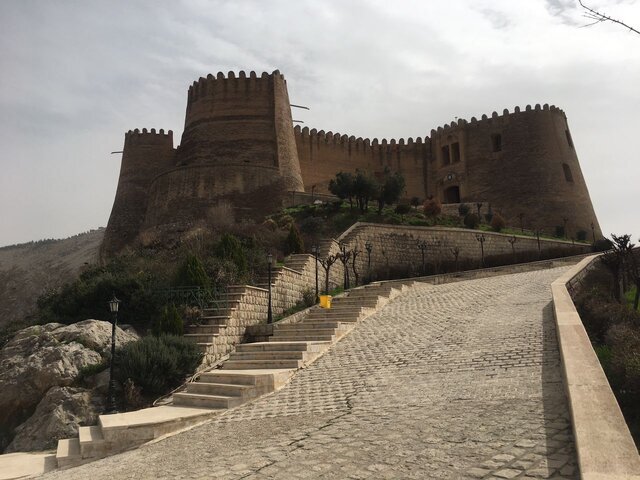Sassanid fortress in Lorestan being restored

TEHRAN –Qale Falak-ol-Aflak, which is a Sassanid era (224–651) fortress located in Khorramabad, the capital of western Lorestan province, has undergone some rehabilitation works, the provincial tourism chief has said.
In order to prevent the valuable historical structure from being destroyed, restoration work has begun on it, Ata Hassanpur said on Wednesday.
The castle is the most important historical monument in the city and province, which is considered the identity of the people of Lorestan, the official added.
The castle has become a cultural and historical landmark for this city, attracting visitors from all over, he noted.
There has been damage to this monument in recent years, but it has not been destroyed, he mentioned.
The restoration project is being carried out by experienced restorers under the supervision of cultural heritage experts, he explained.
Back in July, deputy tourism minister Ali Darabi announced that Iran eyes the UNESCO World Heritage tag for its Qale Falak-ol-Aflak.
“UNESCO registration of Khorramabad’s Falak-ol-Aflak fortress is of high importance as it is a public demand on the one hand, and is emphasized by the president [Ebrahim Raisi] on the other hand,” he said.
The Ministry of Cultural Heritage, Tourism, and Handicrafts is ready to compile a specific dossier on the ancient fortress and surrounding properties for possible inscription on the UNESCO list, Darabi said.
Moreover, the ministry is ready to invite UNESCO experts to visit and assess this unique historical work, he noted.
The unmissable eight-towered fortress dominates Khorramabad as one of the most visited travel destinations in the region for both domestic and foreign sightseers. The fortress seems particularly imposing and dramatic when floodlit at night, offering picturesque views of its encircling crenelated battlements.
Experts believe that the fortress is comparable with similar works in Naqsh-e Rostam, Naqsh-e Rajab, Tape Chugan, and Firuzabad in Fars province.
In 2018, UNESCO added an ensemble of Sassanian historical cities in southern Iran -- titled “Sassanid Archaeological Landscape of Fars Region”-- to its World Heritage list. The ensemble is comprised of eight archaeological sites situated in three geographical parts of Firuzabad, Bishapur, and Sarvestan.
It reflects the optimized utilization of natural topography and bears witness to the influence of Achaemenid and Parthian cultural traditions and of Roman art, which later had a significant impact on the architecture and artistic styles of the Islamic era.
The Sassanid era is of very high importance in the history of Iran. Under Sassanids, Persian art and architecture experienced a general renaissance. Architecture often took grandiose proportions such as palaces at Ctesiphon, Firuzabad, and Sarvestan which are amongst the highlights of the ensemble.
Crafts such as metalwork and gem-engraving grew highly sophisticated, yet scholarship was encouraged by the state. In those years, works from both the East and West were translated into Pahlavi, the language of the Sassanians.
Efforts made by the Sassanids also yield a revival of Iranian nationalism took place, for example, Zoroastrianism was declared the state religion. The dynasty evolved by Ardashir I and was destroyed by the Arabs during the period 637 to 651. The dynasty was named after Sasan, an ancestor of Ardashir I.
Under his leadership who reigned from 224 to 241, the Sassanians overthrew the Parthians and created an empire that was constantly changing in size as it reacted to Rome and Byzantium to the west and the Kushans and Hephthalites to the east, according to Britannica Encyclopedia.
At the time of Shapur I (reigned 241 CE–272), the empire stretched from Sogdiana and Iberia (Georgia) in the north to the Mazun region of Arabia in the south; in the east, it extended to the Indus River and the west to the upper Tigris and Euphrates river valleys.
Soaked in history and culture, Lorestan is one of the lesser-known travel destinations in Iran, which mainly acts as a gateway to the sweltering plains below in the adjoining Khuzestan province. Lorestan is also a region of raw beauty that an avid nature lover could spend weeks exploring.
ABU/MG
Leave a Comment